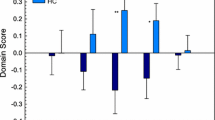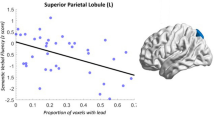Abstract
Purpose
This study aimed to investigate differences in static and dynamic functional network connectivity (FNC) and explore their association with neurocognitive performance in acute mild traumatic brain injury (mTBI).
Methods
A total of 76 patients with acute mTBI and 70 age-matched and sex-matched healthy controls were enrolled (age 43.79 ± 10.22 years vs. 45.63 ± 9.49 years; male/female: 34/42 vs. 38/32; all p > 0.05) and underwent resting-state functional magnetic resonance imaging (fMRI) scan (repetition time/echo time = 2000/30 ms, 230 volumes). Independent component analysis was conducted to evaluate static and dynamic FNC patterns on the basis of nine resting-state networks, namely, auditory network (AUDN), dorsal attention network (dAN), ventral attention network (vAN), default mode network (DMN), left frontoparietal network (LFPN), right frontoparietal network (RFPN), somatomotor network (SMN), visual network (VN), and salience network (SN). Spearman’s correlation among aberrances in FNC values, and Montreal cognitive assessment (MoCA) scores was further measured in mTBI.
Results
Compared with controls, patients with mTBI showed wide aberrances of static FNC, such as reduced FNC in DMN–vAN and VN–vAN pairs. The mTBI patients exhibited aberrant dynamic FNC in state 2, involving reduced FNC aberrance in the vAN with AUDN, VN with DMN and dAN, and SN with SMN and vAN. Reduced dFNC in the SN–vAN pair was negatively correlated with the MoCA score.
Conclusion
Our findings suggest that aberrant static and dynamic FNC at the acute stage may contribute to cognitive symptoms, which not only may expand knowledge regarding FNC cognition relations from the static perspective but also from the dynamic perspective.




Similar content being viewed by others
References
Kamins J, Giza CC. Concussion-mild traumatic brain injury: recoverable injury with potential for serious sequelae. Neurosurg Clin N Am. 2016;27:441–52.
Levin HS, Diaz-Arrastia RR. Diagnosis, prognosis, and clinical management of mild traumatic brain injury. Lancet Neurol. 2015;14:506–17.
Hou J, Nelson R, Wilkie Z, Mustafa G, Tsuda S, Thompson FJ, Bose P. Mild and mild-to-moderate traumatic brain injury-induced significant progressive and enduring multiple comorbidities. J Neurotrauma. 2017;34:2456–66.
Vergara VM, Mayer AR, Damaraju E, Calhoun VD. The effect of preprocessing in dynamic functional network connectivity used to classify mild traumatic brain injury. Brain Behav. 2017;7:e00809.
Mayer AR, Mannell MV, Ling J, Gasparovic C, Yeo RA. Functional connectivity in mild traumatic brain injury. Hum Brain Mapp. 2011;32:1825–35.
Iraji A, Benson RR, Welch RD, O Neil BJ, Woodard JL, Ayaz SI, Kulek A, Mika V, Medado P, Soltanian-Zadeh H, Liu T, Haacke EM, Kou Z. Resting state functional connectivity in mild traumatic brain injury at the acute stage: independent component and seed-based analyses. J Neurotrauma. 2015;32:1031–45.
Zhou Y, Milham MP, Lui YW, Miles L, Reaume J, Sodickson DK, Grossman RI, Ge Y. Default-mode network disruption in mild traumatic brain injury. Radiology. 2012;265:882–92.
Lu L, Li F, Chen H, Wang P, Zhang H, Chen YC, Yin X. Functional connectivity dysfunction of insular subdivisions in cognitive impairment after acute mild traumatic brain injury. Brain Imaging Behav. 2020;14:941-8.
Li F, Lu L, Shang S, Hu L, Chen H, Wang P, Zhang H, Chen YC, Yin X. Disrupted functional network connectivity predicts cognitive impairment after acute mild traumatic brain injury. CNS Neurosci Ther. 2020;26:1083–91.
Vergara VM, Mayer AR, Damaraju E, Kiehl KA, Calhoun V. Detection of mild traumatic brain injury by machine learning classification using resting state functional network connectivity and fractional anisotropy. J Neurotrauma. 2017;34:1045–53.
Allen EA, Damaraju E, Plis SM, Erhardt EB, Eichele T, Calhoun VD. Tracking whole-brain connectivity dynamics in the resting state. Cereb Cortex. 2014;24:663–76.
Sakoğlu U, Pearlson GD, Kiehl KA, Wang YM, Michael AM, Calhoun VD. A method for evaluating dynamic functional network connectivity and task-modulation: application to schizophrenia. Magma. 2010;23:351–66.
Hutchison RM, Womelsdorf T, Allen EA, Bandettini PA, Calhoun VD, Corbetta M, Della Penna S, Duyn JH, Glover GH, Gonzalez-Castillo J, Handwerker DA, Keilholz S, Kiviniemi V, Leopold DA, de Pasquale F, Sporns O, Walter M, Chang C. Dynamic functional connectivity: promise, issues, and interpretations. Neuroimage. 2013;80:360–78.
Mayer AR, Ling JM, Allen EA, Klimaj SD, Yeo RA, Hanlon FM. Static and dynamic intrinsic connectivity following mild traumatic brain injury. J Neurotrauma. 2015;32:1046–55.
Wang J, Wang X, Xia M, Liao X, Evans A, He Y. GRETNA: a graph theoretical network analysis toolbox for imaging connectomics. Front Hum Neurosci. 2015;9:386. Erratum in: Front Hum Neurosci. 2015;9:458.
Wang C, Cai H, Sun X, Si L, Zhang M, Xu Y, Qian Y, Zhu J. Large-scale internetwork functional connectivity mediates the relationship between serum triglyceride and working memory in young adulthood. Neural Plast. 2020;2020:8894868.
Ashburner J. A fast diffeomorphic image registration algorithm. Neuroimage. 2007;38:95–113.
Jiang SF, Shi JY, Yang ZT, Zhang L, Chen HJ. Aberrant dynamic functional network connectivity in cirrhotic patients without overt hepatic encephalopathy. Eur J Radiol. 2020;132:30.
Liu F, Xie B, Wang Y, Guo W, Fouche JP, Long Z, Wang W, Chen H, Li M, Duan X, Zhang J, Qiu M, Chen H. Characterization of post-traumatic stress disorder using resting-state fMRI with a multi-level parametric classification approach. Brain Topogr. 2015;28:221–37.
Du Y, Pearlson GD, Yu Q, He H, Lin D, Sui J, Wu L, Calhoun VD. Interaction among subsystems within default mode network diminished in schizophrenia patients: A dynamic connectivity approach. Schizophr Res. 2016;170:55–65.
Malhi GS, Das P, Outhred T, Bryant RA, Calhoun V. Resting-state neural network disturbances that underpin the emergence of emotional symptoms in adolescent girls: resting-state fMRI study. Br J Psychiatry. 2019;215:545–51.
Johnson B, Zhang K, Gay M, Horovitz S, Hallett M, Sebastianelli W, Slobounov S. Alteration of brain default network in subacute phase of injury in concussed individuals: resting-state fMRI study. Neuroimage. 2012;59:511–8.
Sours C, Zhuo J, Janowich J, Aarabi B, Shanmuganathan K, Gullapalli RP. Default mode network interference in mild traumatic brain injury—a pilot resting state study. Brain Res. 2013;1537:201–15.
Liu J, Xu P, Zhang J, Jiang N, Li X, Luo Y. Ventral attention-network effective connectivity predicts individual differences in adolescent depression. J Affect Disord. 2019;252:55–9.
Corbetta M, Patel G, Shulman GL. The reorienting system of the human brain: from environment to theory of mind. Neuron. 2008;58:306–24.
Vossel S, Geng JJ, Fink GR. Dorsal and ventral attention systems: distinct neural circuits but collaborative roles. Neuroscientist. 2014;20:150–9.
Stamatakis EA, Wilson JT, Hadley DM, Wyper DJ. SPECT imaging in head injury interpreted with statistical parametric mapping. J Nucl Med. 2002;43:476–83.
Kato T, Nakayama N, Yasokawa Y, Okumura A, Shinoda J, Iwama T. Statistical image analysis of cerebral glucose metabolism in patients with cognitive impairment following diffuse traumatic brain injury. J Neurotrauma. 2007;24:919–26.
Nakashima T, Nakayama N, Miwa K, Okumura A, Soeda A, Iwama T. Focal brain glucose hypometabolism in patients with neuropsychologic deficits after diffuse axonal injury. AJNR Am J Neuroradiol. 2007;28:236–42.
Kim J, Whyte J, Patel S, Europa E, Slattery J, Coslett HB, Detre JA. A perfusion fMRI study of the neural correlates of sustained-attention and working-memory deficits in chronic traumatic brain injury. Neurorehabil Neural Repair. 2012;26:870–80.
Palacios EM, Yuh EL, Chang YS, Yue JK, Schnyer DM, Okonkwo DO, Valadka AB, Gordon WA, Maas AIR, Vassar M, Manley GT, Mukherjee P. Resting-state functional connectivity alterations associated with six-month outcomes in mild traumatic brain injury. J Neurotrauma. 2017;34:1546–57.
Jerde TA, Merriam EP, Riggall AC, Hedges JH, Curtis CE. Prioritized maps of space in human frontoparietal cortex. J Neurosci. 2012;32:17382–90.
Vakhtin AA, Calhoun VD, Jung RE, Prestopnik JL, Taylor PA, Ford CC. Changes in intrinsic functional brain networks following blast-induced mild traumatic brain injury. Brain Inj. 2013;27:1304–10.
Chand GB, Wu J, Hajjar I, Qiu D. Interactions of insula subdivisions-based networks with default-mode and central-executive networks in mild cognitive impairment. Front Aging Neurosci. 2017;9:367.
Seeley WW, Menon V, Schatzberg AF, Keller J, Glover GH, Kenna H, Reiss AL, Greicius MD. Dissociable intrinsic connectivity networks for salience processing and executive control. J Neurosci. 2007;27:2349–56.
Jilka SR, Scott G, Ham T, Pickering A, Bonnelle V, Braga RM, Leech R, Sharp DJ. Damage to the Salience Network and interactions with the Default Mode Network. J Neurosci. 2014;34:10798–807.
Kuiper JJ, Lin YH, Young IM, Bai MY, Briggs RG, Tanglay O, Fonseka RD, Hormovas J, Dhanaraj V, Conner AK, O’Neal CM, Sughrue ME. A parcellation-based model of the auditory network. Hear Res. 2020;396:108078.
Nourski KV, Steinschneider M, McMurray B, Kovach CK, Oya H, Kawasaki H, Howard MA 3rd. Functional organization of human auditory cortex: investigation of response latencies through direct recordings. Neuroimage. 2014;101:598–609.
Giraud AL, Kleinschmidt A, Poeppel D, Lund TE, Frackowiak RS, Laufs H. Endogenous cortical rhythms determine cerebral specialization for speech perception and production. Neuron. 2007;56:1127–34.
Morillon B, Lehongre K, Frackowiak RS, Ducorps A, Kleinschmidt A, Poeppel D, Giraud AL. Neurophysiological origin of human brain asymmetry for speech and language. Proc Natl Acad Sci USA. 2010;107:18688–93.
D’Souza MM, Kumar M, Choudhary A, Kaur P, Kumar P, Rana P, Trivedi R, Sekhri T, Singh AK. Alterations of connectivity patterns in functional brain networks in patients with mild traumatic brain injury: A longitudinal resting-state functional magnetic resonance imaging study. Neuroradiol J. 2020;33:186–97.
Widjaja E, Zamyadi M, Raybaud C, Snead OC, Smith ML. Abnormal functional network connectivity among resting-state networks in children with frontal lobe epilepsy. AJNR Am J Neuroradiol. 2013;34:2386–92.
Stevens MC, Lovejoy D, Kim J, Oakes H, Kureshi I, Witt ST. Multiple resting state network functional connectivity abnormalities in mild traumatic brain injury. Brain Imaging Behav. 2012;6:293–318.
Funding
This work was supported by the Natural Science Foundation of China (No.82102012, 82102006), Natural Science Foundation of Jiangsu Province (No. BK20201118) and 333 High-level Talents Training Project of Jiangsu Province (No. BRA2019122).
Author information
Authors and Affiliations
Contributions
LL and JZ are co-first authors of this paper, they designed the experiment, analyzed the data and drafted the paper. FL and SS helped to acquire the clinical and fMRI data. HC and XY helped to revise the paper critically for important intellectual content. WG and YCC are co-corresponding authors of this paper, they did the financial support, reviewed and approved the final manuscript.
Corresponding authors
Ethics declarations
Conflict of interest
L. Lu, J. Zhang, F. Li, S. Shang, H. Chen, X. Yin, W. Gao and Y.-C. Chen declare that they have no competing interests.
Ethical standards
All procedures performed in studies involving human participants or on human tissue were in accordance with the ethical standards of the institutional and/or national research committee and with the 1975 Helsinki declaration and its later amendments or comparable ethical standards. The current study was approved by the Research Ethics Committee of the Nanjing Medical University. All participants provided written informed consent before undergoing MR imaging.
Additional information
The authors Liyan Lu and Juan Zhang contributed equally to this work. The corresponding authors Wei Gao and Yu-Chen Chen contributed equally to this work.
Consent to Publish: not applicable.
Availability of data and materials: imaging data could be provided upon request.
Rights and permissions
About this article
Cite this article
Lu, L., Zhang, J., Li, F. et al. Aberrant Static and Dynamic Functional Network Connectivity in Acute Mild Traumatic Brain Injury with Cognitive Impairment. Clin Neuroradiol 32, 205–214 (2022). https://doi.org/10.1007/s00062-021-01082-6
Received:
Accepted:
Published:
Issue Date:
DOI: https://doi.org/10.1007/s00062-021-01082-6




